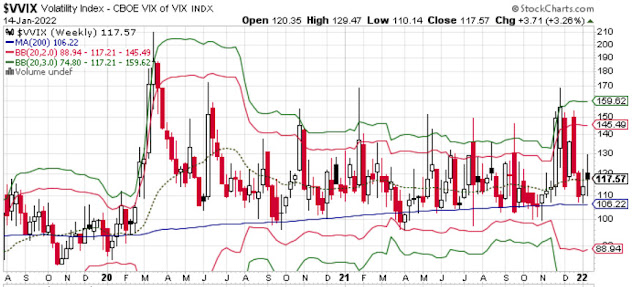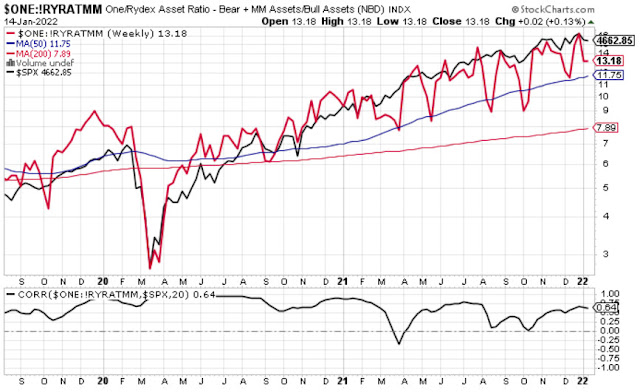 |
| Figure 1. A chart of $SPXEW (on 12/02/2021) with the Ichimoku trading strategy |
Ichimoku Cloud System
Ichimoku Cloud is a set of indicators designed as a standalone trading system. These indicators can be used to identify support and resistance, determine trend direction and generate trading signals. Ichimoku Kinko Hyo, the Japanese name for the technique, is translated as “one look equilibrium chart (一目均衡圖).” With one look, chartists can identify the trend and look for potential signals within that trend.
For example, @Mayhem4Markets has used Ichimoku Cloud (see Figure 1) to analyze the trend of $SPXEW (S&P 500 equal weight) as follows:
$SPXEW back in to the cloud here, neutralizing a near term downtrend potentially. Watch overhead resistance. I like using $SPXEW sometimes since it shows more about breadth (or the lack thereof) in its price action.
In the opinion of @ndshah26, he also think high of Ichimoku Cloud System:
Glad to see some other people using the Ichimoku cloud system…Its a real good indicator and works pretty well with MACD and ADX (see Figure 2)…Just in case you haven’t tried it already?
 |
| Figure 2. A chart of $NDX (on 01/21/2022) with Ichimoku Cloud, MACD and ADX |
Basic Lines of the Ichimoku Cloud
- Tenkan-sen (Conversion Line or 轉換線)
- On a daily chart, this line is the midpoint of the 9-day high-low range, which is almost two weeks.
- The Conversion Line (blue) is a relatively short-term indicator designed to catch turns early. Catching the turn early will improve the risk-reward ratio for trades.
- Kijun-sen (Base Line or 基線)
- On a daily chart, this line (red) is the midpoint of the 26-day high-low range, which is almost one month.
- Senkou Span A (Leading Span A or 先行帶A)
- This is the midpoint between the Conversion Line and the Base Line.
- The Leading Span A forms one of the two Cloud boundaries. It is referred to as “Leading” because it is plotted 26 periods in the future and forms the faster Cloud boundary.
- Senkou Span B (Leading Span B or 先行帶B)
- On the daily chart, this line is the midpoint of the 52-day high-low range, which is a little less than 3 months. The default calculation setting is 52 periods, but it can be adjusted.
- This value is plotted 26 periods in the future and forms the slower Cloud boundary.
- Chikou Span (Lagging Span or 遲行帶)
- This line (green) is created by plotting closing prices 26 periods behind the latest closing price of an asset.
Video 1. Trading strategies discussed using the latest stock market (YouTube link)
Trading Strategies
Watch Video 1 for the demonstration of using Ichimoku Cloud strategy in the latest stock market (as of 01/23/2022). But, the basic principles can be summarized as the below:[1]
Chartists use the actual cloud to identify the overall trend and establish a trading bias. Once said bias is established, chartists will wait for a correction when prices cross the Base Line (red). An actual signal triggers when prices cross the Conversion Line (blue) to signal an end to the correction.
This trading strategy will set three criteria for a bullish signal:
- Price is above the lowest line of the cloud (bullish bias)
- In other words, prices are either above the cloud or remain above cloud support.
- Price moves below the Base Line (pullback)
- It improves the risk-reward ratio for new long positions
- Price Moves above the Conversion Line (upturn)
- A bullish signal triggers when prices reverse and move above the Conversion Line (blue).
First, the trend is bullish as defined by the cloud. Second, the stock pulls back with a move below the Base Line. Third, the stock turns back up with a move above the Conversion Line.Bearish Signal
This trading strategy will also set three criteria for a bearish signal:
- Price is below the highest line of the cloud (bearish bias)
- This means price is either below the cloud or has yet to break above cloud resistance.
- Price moves above the Base Line (bounce)
- This signals a bounce within a bigger downtrend
- Price moves below the Conversion Line (downturn)
- A bearish signal triggers when prices reverse and move below the Conversion Line.






